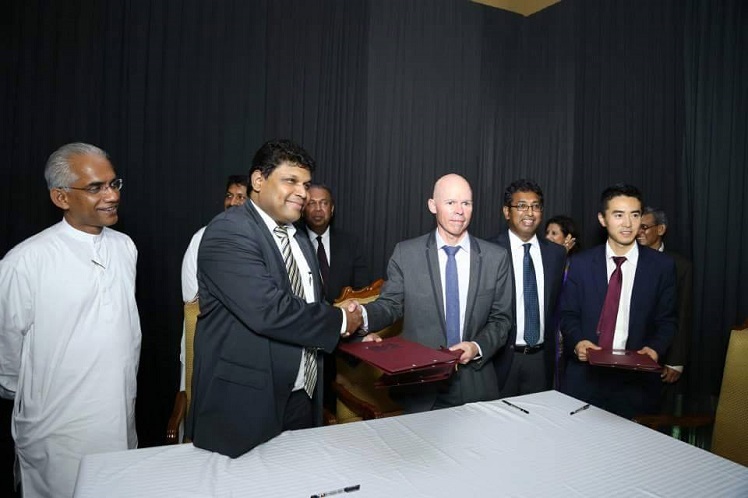With the internet being available to almost the entire world, there yet remains a significant portion of the population that has no access to the internet. That’s the problem that Google set out to solve with their “Google Loon” project. The concept was simple. Launch a few hundred (or thousand) balloons into the sky. These balloons would be specially equipped with hardware that is capable of directing and distributing LTE wireless signals back to earth. Think of them as mobile hotspots that float above your head. As such they would be capable of transmitting these wireless signals back to earth so that people can access the internet via these same signals. The premise was that if infrastructure is the issue, it no longer needed to be.
When proposed, it sounded like the ideal plan for third world countries whose economy lacked the required funding to set up a network infrastructure to cover the entire country. Everything was hunky dory.
Fast forward to today (28th July)
The Information and Communication Technology Agency of Sri Lanka (ICTA) is pleased to invite you to the launch of the “Digital Infrastructure, Unimagined!” initiative scheduled to be held on the 28th July 2015 from 9.30 am onwards at Temple Trees.
This initiative is anticipated to transform Sri Lanka’s ICT landscape to the next level and lead Sri Lanka towards experiencing cutting edge technology in the use of ICT’s and will give unimaginable opportunities for Sri Lankan Public Sector, Telecommunication Sector and The Citizens to experience the latest state of the art digital infrastructure technology.
This piqued our curiosity. The above was taken from the Facebook status of Sanjiva Weerawarana, Founder, CEO and Chief Architect of WSO2. The event in this case was presided over by the Minister of Foreign Affairs, Telecoms & IT Hon. Min. Mangala Samaraweera and it is here that those attending go the shock of their lives when none other than Google Vice President Michael Cassidy himself accompanied the minister to reveal that Sri Lanka has been chosen to be the very first country to have full internet coverage courtesy of the “Google Loon” project.

This certainly caught everyone by surprise. Quite so in fact that none of the major Telecommunication Operators present at the meeting had the slightest notion that Loon would be launched in Sri Lanka. This of course raised numerous other questions and for a good one to two hours, all social media outlets were a flurry of activity.
As you can see, the Minister’s twitter activity was fluttering with *ahem* tweets. But that’s not all. This is where things became even more interesting. Leave it to people to jump to conclusions and you’ll end up with some mighty fine results.
For example, a friend of mine went about Facebook proudly proclaiming that since Google Loon is here, he can bid farewell to his mediocre internet connection and embrace Google’s internet. It took him a good while to understand that Google would have nothing to do with providing internet but rather would be using the existing infrastructure to boost the coverage of internet to rural areas and that he would in fact still be using his “mediocre” connection.
Another wild theory that surfaced was that Google would be providing free internet courtesy of Google Fiber to Sri Lanka thus rendering all TelCos obsolete. This too was met with a solid wall of explanation and a good dose of reading up online for him to come to his (partial) senses.
Then you get the political influences that call foul play because of the upcoming elections and see the Loon project as an attempt to boost the standings of certain political parties. How true this is we don’t know and quite frankly, some questions are better left unanswered.
There are however, some questions that we would like some answers for. Namely,
- How was it even possible to launch a project of this magnitude in Sri Lanka without a single Telco getting wind about it?
- According to Google, Loon would be akin to a service provider providing service to those in rural areas. To do this, they would need the coorperation of existing TelCos to beam their LTE signals to the balloons in order to transmit them to the rural areas. Just run me by on exactly how this would be done without the prior knowledge of the TelCos?
- Google, acting as the intermediary for this would obviously be looking to get a cut from providing the service. The question is, exactly how much of a cut are we looking at here? And who pays for it? The TelCo? So does that mean the TelCo in turn would burden that cost on the consumer? And if so, how much of it would the consumer have to bear?
- Where exactly are we getting the funding for all this? The Loon project relies on specially developed balloons. Will Google provide these for free? Or do we have to pay for it? Our current state of affairs (with the upcoming elections and numerous other projects) means that we are not exactly rolling around in wealth either. So do we have the funds to spend for all this?
- If you recall, several months ago, ICTA launched a project that would provide free WiFi to all major areas of public access. The premise back then was that each citizen who connects to the service would be allocated 100MB of data per month. Later this was reshuffled to look like a big data analysis where the government and those involved would analyze the data find out what areas had the most amount of data usage and at what time etc. Well what happens to that now? If ICTA was indeed in talks with Google to get Project Loon up and running, then why spend all those resources on the “Free WiFi” project?

We got in touch with major TelCos who attended this event and even to get in touch with members of ICTA, including the CEO of ICTA, Muhunthan Canagey, however they declined to comment. But nonetheless, we will remain vigilant with regard to this matter.
Testing for Project Loon would apparently begin in December 2015 and upon successful completion, the project should be up and running by 2016. I guess well just have to see how true this is.
All in all, we aren’t against Google’s Loon project at all. Rather, we welcome it with open arms. The simplicity of the project means that we can actually provide decent bandwidth to those in rural areas. The question remains though, at what cost?






This is another politically driven event. Before the last election, they promised free Wi-Fi and now they do promise the loon. Mugunthan is a well known unp activist who did organize several election-related campaigns for the UNP.
ICTA should be the connecting body of the IT/Telco industry not work as individual arm.
What’s with ICTA and this Free wi-fi?
It’s another bullshit promise like Ranil used to say, he will give FREE gold chains and bracelets back in the day. Anyways, Google doesn’t provide free-wifi, they usually partner with a telco (SLT/Dialog) to provide the service, and they are not in the business of providing anything free for my knowledge.
to be fair Mugunthan is also th guy who fiunded EPSI computers and CBNSat he is person from a tech background.
The article is a set of assumptions in its entirety – too many ‘what ifs’ included i.e; what if the Telcos were already informed? what if Telecom/Mobitel (where the SLG is a stakeholder) decides to pioneer the Loon project? what if Google guys were just on vacation in SL and then someone shouted “loon” and then bum dum dish ” we have ourselves a Loon project? – we don’t know do we? Also the writer has not condemned any political party so the viewers must not look at the course of dealings on a political perspective. Added as far as my knowledge on General Election is concerned none of the election manifestos include anything about updating whole of SL to wifii moderate (Except maybe UNF with something about ‘digitized economy’) with the help of Google. So basically, it’s too soon to say anything about this project – so lets not start to criticise/comment on something (good) that has not even started yet shall we? We’ll keep that for later.
ICTA being under the foreign ministry now, everything seem alienated for these guys!
NSA Prism project
Surveillance and influencing of the public
You wrote almost every line with “What ifs” and you call this an article ? Seriously – Please tell us one fact you have written here about the “Loon” project and its implementations in Sri Lanka – For sure this comment will no go live as well – but this is just just gossip we already know and we don’t need to here the same again. Anyway you got your title correct “Google Loon Launches In Sri Lanka” 🙂
So the loon network 60km up in the sky is supposed to replace the terrestrial backbone. The loon balloons are to be replaced every 60 to 100 days1 The main internet feed will have to be shot up to a mother balloon to be distributed amongst the other loons and then connect to the terrestrial BB network/s. This infrastructure would be extremely expensive and I doubt that a developing country like SL could afford it. Maybe Google is providing this solution foc under their charity framework. I sure would pinch myself send wake up! Expanding our existing terrestrial infrastructure would probably be cheaper.
මෙය තනිකරම අපේ රටේ තොරතුරු හොරෙන් ගන්න ගහපු ගැටයක්. මෙම බැලූන් වලට අමුණා ඇති උපකරණ මගින් 4G LTE නමැති අධිවේග රැහැන් රහිත දත්ත හුවමාරු කරන තාක්ෂනය හරහා සීමිත පිරිසකට අනතර්ජාල සේවා සැපයිය හැක. ලංකාවේ සාමාන්ය ජනතාවගෙන් කී දෙනෙකුට 4G තාක්ෂනය සහිත ජංගම උපකරණ තිබේද?. එදිනෙදා ජීවිතය පවත්වාගෙනයාම සඳහා පොරබදන ලාංකීය පොදු ජනතාවට මෙයින් ලැබෙන්නේ මොනවාද?. මෙය ඔවුන්ගේ මූලික ප්රශ්න විසදීමක්ද? දැනටමත් ලංකාවේ ක්රියාත්මක වන අන්තර්ජාල සපයන ආයතන මුළු රටම ආවරණය කර ඇති මොහොතක මෙයින් ජනතාවට ලැබෙන විශේෂ වාසිය කුමක්ද?
එක් බැලූනයක් මගින් වර්ග කිලෝමීටර 5000 ප්රමාණයක් ආවරණය කල හැකි බවට පැවසුවද එමගින් එකවර සැපයිය හැක්කේ අන්තර්ජාල සබඳතා සිය ගණනක් පමණි. ගූගල් ලූන් වෙබ් අඩවියේම මෙය සඳහන්ව ඇත. ඒ අනුව බැලූන් 13 මගින් ලංකාවම ආවරණය කලද ලබාදිය හැකි සම්බන්දතා ගණන ඉතා අඩුය. එමෙන්ම මෙම බැලූන සඳහා අන්තර්ජාල සම්බන්දතාවය ලබාදිය යුත්තේ අන්තර්ජාල සේවා සපයන සමාගම් මගිනි.මෙසේ ලබාදෙන සම්බන්ධතාවයේ ධාරිතාව බැලූනය හා 4G තාක්ෂණයෙන් සම්බන්ධවන පුද්ගලයන් අතර බෙදී යන බැවින් අන්තර්ජාලයට සම්බන්ධවියහැකි වේගය ඒ අනුව තීරණය වේ.
ගූගල් ලූන් තාක්ෂනය 2013 වසරේදී නවසීලන්තයේදී පමණක් අත්හදා බැලීම් කරන ලද , වෙනත් කිසිම ආකාරයෙන් අන්තර්ජාල සේවා සැපයිය නොහැකි භූමි ප්රදේශවල සිටින සීමිත පිරිසකට අන්තර්ජාල සේවා සැපයීම සඳහා භාවිතයට යෝජනා කර ඇති ක්රමයකි. මෙයට උදාහරණ ලෙස කඳුකර ප්රදේශ , කාන්තාර නම් කල හැක. දින 100කට වරක් නැවත නැවත බැලූන යැවිය යුතුය.වෙනත් කිසිදු රටක් මෙම තාක්ෂනය පාවිච්චි නොකරන්නේ එය වියදම් අධික බැවිනි. අධික මිලකින් යුත් මෙවැනි බැලූන ඇමෙරිකාවේ සිට මෙරටට නොමිලේ එවන්නේනම් එය පිටුපස ඇත්තේ කුමක්දැයි සොයා බැලිය යුතු කාරණාවකි.ඇමෙරිකානු සමාගමකට තම ගුවන් සීමාවේ රිසිසේ බැලූන හසුරවා ඔත්තු බැලීමට ඉඩදෙන ලෝකයේ පළමු මෝඩයන් සිටින රට බවට අපි පත්ව ඇත්තෙමු.
මෙම ව්යාපෘතිය ක්රියාත්මක කිරීම සඳහා ඇමතිවරුන් කිහිපදෙනෙකු නිතර නිතර විදෙස් ගත වන අතර ඔවුන්ගේ හිතවතෙකු මේ සඳහාම ආයතනයක් ලියාපදිංචි කර ඇත්තේ කුමක් සඳහාදැයි සිතීම ඔබට බාරය. අවසානයේ මෙම සියල්ලේ බරපැන විදීමට සිදුවන්නේ රටේ සාමාන්ය ජනතාවටයි. තොරතුරු තාක්ෂණ නියෝජිතායතනයට ක්රියාත්මක කිරීම සඳහා ජනතාවට ප්රයෝජනවත් වන වෙනත් ව්යපෘති ඇත්තේම නැද්ද?